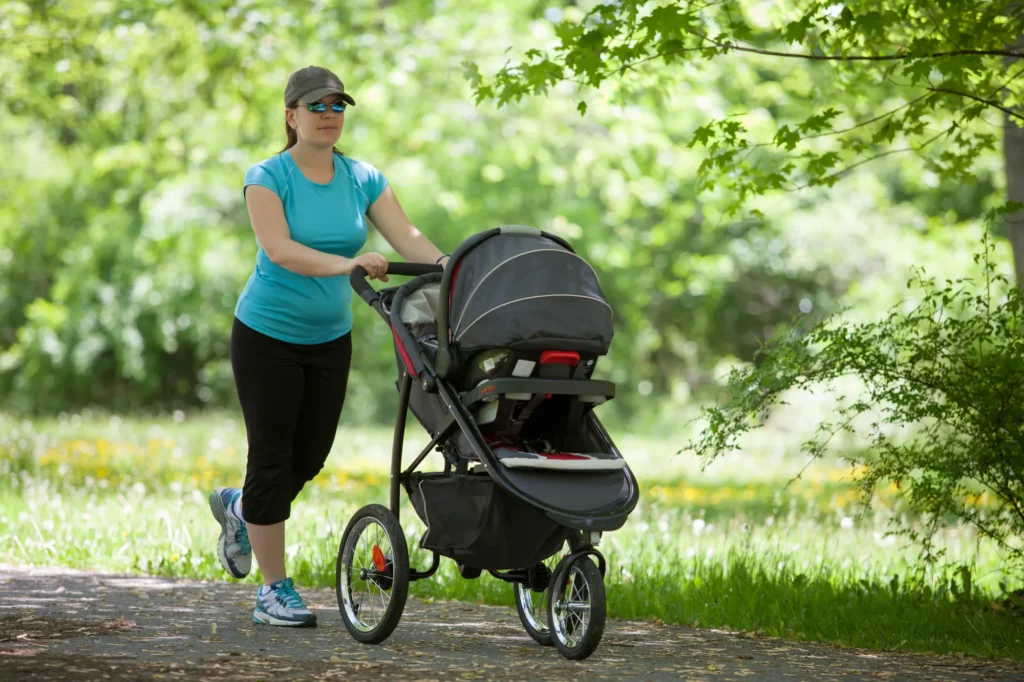Returning to running after having a baby is no small step – literally.
Running is a high-impact activity that increases pressure within the abdomen, and the forces that act on the body and joints can more than double those experienced in walking. That being said, running postpartum is achievable, safe, and a great form of exercise with appropriate support and adherence to guidelines.
Body changes throughout the pregnancy journey
There are a variety of anatomical and physiological changes that occur during and following pregnancy, in addition to the changes that new mothers face in their daily routine, sleep schedule, and energy levels.
A significant amount of change can occur in the pelvic floor muscles, which help to support pelvic organs (bladder, reproductive organs), provide stability for the low back and pelvis, and aid in controlling bowel and bladder continence. The muscles in the pelvic floor can become lengthened and weakened during the delivery process. As well, the joints and ligaments in the pelvis become more mobile throughout pregnancy to accommodate the growing baby.
Finally, the mother’s diaphragm and lungs are pushed upward, which can affect breathing patterns and core activation.



Have you met our Pelvic Floor Physiotherapists?
We use a whole-person approach to ensure every patient feels safe and supported, while aiming to create a collaborative rehabilitation process.
Timeline expectations
Evidence shows that return to running postpartum should start no sooner than 3 months following delivery (Goom et al., 2019)
Until this 12 week mark, new mothers can participate in graduated lower impact activities such as walking, basic core exercises, and pelvic floor muscle training. It is recommended that all new mothers undergo a 6-week postnatal checkup to evaluate current symptoms and functional ability.
For running with a stroller, experts advise that this should not begin before the baby is 6-9 months old in order to protect the baby’s neck and spine. Buggy running also comes with increased energy demand and changes to hip and knee kinematics for the running, so additional strength and conditioning exercises are advisable (These parameters are here as a guide and are not one-size-fits-all, so as always, listen to the advice of your own healthcare practitioners.)

Postpartum considerations and seeking support
Body changes during & after pregnancy may lead to a variety of symptoms that can be addressed with pelvic floor physiotherapy and rehabilitation. When returning to running postpartum, it is normal to experience muscle soreness that subsides within 30-60 minutes after ceasing activity, as well as a decreased threshold in running frequency, intensity and duration as your body adjusts to a period of time off of running. However, if you are experiencing any of these symptoms, it is not yet time to start running again, and you would likely benefit from pelvic floor physiotherapy.
- Leaking of urine or stool
- Presence of a gap in the midline of abdominal wall
- Feeling of heaviness/dragging in the vagina
- Ongoing pelvic or low back pain
These changes are common; however working with a pelvic floor physiotherapist can help manage and improve symptoms, and support return to running as well as overall quality of life. Engaging in pelvic floor muscle training can reduce the odds of prenatal urinary incontinence by 50% and postnatal urinary incontinence by 37% (Davenport et al., 2018).
For additional information on running postpartum, check out this guideline for postnatal return to running. If you are interested in pursuing pelvic floor physiotherapy, book with Taylor to help with your perinatal and postnatal concerns, including return to running.
Written by: Taylor Forster, Physiotherapist with Pelvic Floor Advanced Training
References
Alcantara, R. S., & Wall-Scheffler, C. M. (2017). Stroller running: energetic and kinematic changes across pushing methods. Plos one, 12(7), e0180575.
Davenport, M. H., Nagpal, T. S., Mottola, M. F., Skow, R. J., Riske, L., Poitras, V. J., … & Ruchat, S. M. (2018). Prenatal exercise (including but not limited to pelvic floor muscle training) and urinary incontinence during and following pregnancy: a systematic review and meta-analysis. British journal of sports medicine, 52(21), 1397-1404.
Edwards, K. M. (2020). Considerations for the postpartum runner. Strength & Conditioning Journal, 42(1), 45-52.
Goom, T., Donnelly, G., & Brockwell, E. (2019). Returning to running postnatal–guidelines for medical, health and fitness professionals managing this population. Absolute Physio.

